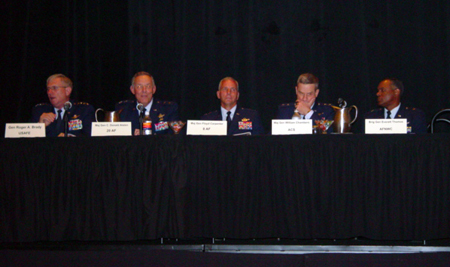Though the B-52 fleet has been one of the centerpieces of the Air Force’s reinvigorated nuclear mission, its capability to launch nuclear cruise missiles remains very much in doubt, as the service’s sole weapon left in its active inventory is slated to retire from service by the end of the decade. However, the Pentagon is pressing the Air Force to come up with possible alternatives, said Maj. Gen. William Chambers, the head of nuclear integration on the Air Staff Monday at AFA’s Air & Space Conference. The Air Force is in the process of reducing its AGM-86 Air Launched Cruise Missile fleet down to 528 weapons, with the remaining weapons due to leave service by 2020—effectively limiting the B-52s nuclear delivery to the B61 gravity bomb. Chambers said the ALCM continues to be a reliable part of the nuclear portfolio, and that Pentagon leadership has directed the service to begin conducting an analysis of alternatives next year for a potential successor to the weapon. “Guidance from that effort has been given from DOD and that effort has begun in earnest,” Chambers told the audience during a panel discussion on the nuclear enterprise. (For more from the panel, read the Daily Report’s Good Start on Nuclear Enterprise, but Work Remains)
the B-52 fleet has been one of the centerpieces of the Air Force’s reinvigorated nuclear mission, its capability to launch nuclear cruise missiles remains very much in doubt, as the service’s sole weapon left in its active inventory is slated to retire from service by the end of the decade. However, the Pentagon is pressing the Air Force to come up with possible alternatives, said Maj. Gen. William Chambers, the head of nuclear integration on the Air Staff Monday at AFA’s Air & Space Conference. The Air Force is in the process of reducing its AGM-86 Air Launched Cruise Missile fleet down to 528 weapons, with the remaining weapons due to leave service by 2020—effectively limiting the B-52s nuclear delivery to the B61 gravity bomb. Chambers said the ALCM continues to be a reliable part of the nuclear portfolio, and that Pentagon leadership has directed the service to begin conducting an analysis of alternatives next year for a potential successor to the weapon. “Guidance from that effort has been given from DOD and that effort has begun in earnest,” Chambers told the audience during a panel discussion on the nuclear enterprise. (For more from the panel, read the Daily Report’s Good Start on Nuclear Enterprise, but Work Remains)
Pentagon Releases Cost of Living, BAH Rates for 2026
Dec. 30, 2025
The Pentagon will pay cost of living allowances to 127,000 service members in the continental U.S. in 2026, an increase of 66,000 members in 2025. Airmen and Guardians across the U.S. will also receive an average increase of 4.2 percent for their Basic Housing Allowance, compared to the 5.4 percent…

